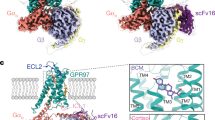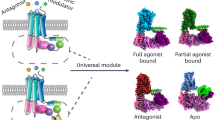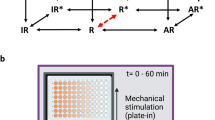Abstract
Tonsillectomy and adenoidectomy (T&A) is a frequent surgical procedure in children with obstructive sleep apnea (OSA). Many symptomatic children who do not fulfill the currently recommended criteria for T&A may benefit from topical intranasal steroid therapy. However, the expression of glucocorticoid receptor (GCR) expression in adenoid and tonsillar tissue is currently unknown. The objective of this study was to assess and compare expression patterns of the human GCR in children who undergo T&A for either recurrent throat infections (RI) or OSA. Adenotonsillar tissues from 36 children with OSA or RI were subjected to quantitative PCR using specific primers for GCR-α and GCR-β and to immunohistochemistry and Western blotting for protein expression of GCR isoforms. mRNA encoding for expression of both GCR-α and GCR-β was detected in the tonsils and adenoids of all children, with markedly higher relative abundance of the GCR-α. Furthermore, GCR-α mRNA expression was increased in OSA-derived adenoid and tonsil tissues compared with RI, whereas no differences emerged for GCR-β. Immunoblots confirmed these findings for the protein transcripts of these genes, and immunohistochemistry showed a specific topographic pattern of distribution for both receptors in tonsillar tissue. GCR-α and GCR-β are expressed in pediatric adenotonsillar tissue, are more abundant in OSA patients, and demonstrate a specific topographic pattern of expression. These findings along with the high GCR-α:GCR-β ratio suggest a favorable profile for topical steroid therapy in snoring children with adenotonsillar hypertrophy.
Similar content being viewed by others
Log in or create a free account to read this content
Gain free access to this article, as well as selected content from this journal and more on nature.com
or
Abbreviations
- GCR:
-
glucocorticoid receptor
- OSA:
-
obstructive sleep apnea
- RI:
-
recurrent throat infections
- T&A:
-
tonsillectomy and adenoidectomy
References
Young T, Peppard PE, Gottlieb DJ 2002 Epidemiology of obstructive sleep apnea: a population health perspective. Am J Respir Crit Care Med 165: 217–1239
Amin RS, Kimball TR, Bean JA, Jeffries JL, Willging JP, Cotton RT, Witt SA, Glascock BJ, Daniels SR 2002 Left ventricular hypertrophy and abnormal ventricular geometry in children and adolescents with obstructive sleep apnea. Am J Respir Crit Care Med 165: 395–1399
de la Eva RC, Baur LA, Donaghue KC, Waters KA 2002 Metabolic correlates with obstructive sleep apnea in obese subjects. J Pediatr 140: 54–659
Gozal D 1998 Sleep-disordered breathing and school performance in children. Pediatrics 102: 16–620
Tal A, Leiberman A, Margulis G, Sofer S 1988 Ventricular dysfunction in children with obstructive sleep apnea: radionuclide assessment. Pediatr Pulmonol 4: 39–143
O'Brien LM, Mervis CB, Holbrook CR, Bruner JL, Smith NH, McNally N, McClimment MC, Gozal D 2004 Neurobehavioral correlates of sleep-disordered breathing in children. J Sleep Res 13: 65–72
Darrow DH, Siemens C 2002 Indications for tonsillectomy and adenoidectomy. Laryngoscope 112: 6–10
Lipton AJ, Gozal D 2003 Treatment of obstructive sleep apnea in children: do we really know how?. Sleep Med Rev 7: 1–80
American Academy of Otolaryngology-Head and Neck Surgery 2000 Clinical Indicators Compendium. American Academy of Otolaryngology-Head and Neck Surgery, Alexandria, 19: 61 – 80
O'Brien LM, Holbrook CR, Mervis CB, Klaus CJ, Bruner J, Raffield TJ, Rutherford J, Mehl RC, Wang M, Tuell A, Hume BC, Gozal D 2003 Sleep and neurobehavioral characteristics in 5- to 7-year-old hyperactive children. Pediatrics 111: 554–563
Montgomery-Downs HE, O'Brien LM, Holbrook CR, Gozal D 2004 Snoring and sleep-disordered breathing in young children: subjective and objective correlates. Sleep 27: 7–94
O'Brien LM, Mervis CB, Holbrook CR, Bruner JL, Klaus CJ, Rutherford J, Raffield TJ, Gozal D 2004 Neurobehavioral implications of habitual snoring in children. Pediatrics 114: 4–49
Al Ghamdi SA, Manoukian JJ, Morielli A, Oudjhane K, Ducharme FM, Brouillette RT 1997 Do systemic corticosteroids effectively treat obstructive sleep apnea secondary to adenotonsillar hypertrophy?. Laryngoscope 107: 382–1387
Brouillette RT, Manoukian JJ, Ducharme FM, Oudjhane K, Earle LG, Ladan S, Morielli A 2001 Efficacy of fluticasone nasal spray for pediatric obstructive sleep apnea. J Pediatr 138: 38–844
Criscuoli G, D'Amora S, Ripa G, Cinquegrana G, Mansi N, Impagliazzo N, Pisacane A 2003 Frequency of surgery among children who have adenotonsillar hypertrophy and improve after treatment with nasal beclomethasone. Pediatrics 111: 236–e238
Hollenberg SM, Weinberger C, Ong ES, Cerelli G, Oro A, Lebo R, Thompson EB, Rosenfeld MG, Evans RM 1985 Primary structure and expression of a functional human glucocorticoid receptor cDNA. Nature 318: 35–641
Adcock IM, Lane SJ 2003 Corticosteroid-insensitive asthma: molecular mechanisms. J Endocrinol 178: 47–355
Christodoulopoulos P, Leung DY, Elliott MW, Hogg JC, Muro S, Toda M, Laberge S, Hamid QA 2000 Increased number of glucocorticoid receptor-beta-expressing cells in the airways in fatal asthma. J Allergy Clin Immunol 106: 79–484
Gagliardo R, Chanez P, Vignola AM, Bousquet J, Vachier I, Godard P, Bonsignore G, Demoly P, Mathieu M 2000 Glucocorticoid receptor alpha and beta in glucocorticoid dependent asthma. Am J Respir Crit Care Med 162: 7–13
Gagliardo R, Vignola AM, Mathieu M 2001 Is there a role for glucocorticoid receptor beta in asthma?. Respir Res 2: 1–4
Hamid QA, Wenzel SE, Hauk PJ, Tsicopoulos A, Wallaert B, Lafitte JJ, Chrousos GP, Szefler SJ, Leung DY 1999 Increased glucocorticoid receptor beta in airway cells of glucocorticoid-insensitive asthma. Am J Respir Crit Care Med 159: 600–1604
Sousa AR, Lane SJ, Cidlowski JA, Staynov DZ, Lee TH 2000 Glucocorticoid resistance in asthma is associated with elevated in vivo expression of the glucocorticoid receptor beta-isoform. J Allergy Clin Immunol 105: 43–950
Goodwin JL, Babar SI, Kaemingk KL, Rosen GM, Morgan WJ, Sherrill DL, Quan SF 2003 Symptoms related to sleep-disordered breathing in white and Hispanic children: the Tucson Children's Assessment of Sleep Apnea Study. Chest 124: 96–203
Oakley RH, Webster JC, Jewell CM, Sar M, Cidlowski JA 1999 Immunocytochemical analysis of the glucocorticoid receptor α isoform (GRα) using GRα-specific antibody. Steroids 64: 42–751
Beger C, Gerdes K, Lauten M, Tissing WJ, Fernandez-Munoz I, Schrappe M, Welte K 2003 Expression and structural analysis of glucocorticoid receptor isoform gamma in human leukaemia cells using an isoform-specific real-time polymerase chain reaction approach. Br J Haematol 122: 45–252
Boullu-Ciocca S, Paulmyer-Lacroix O, Fina F, Ouafik L, Alessi MC, Oliver C, Grino M 2003 Expression of the mRNAs coding for the glucocorticoid receptor isoforms in obesity. Obes Res 11: 25–929
DeRijk RH, Schaaf M, Stam FJ, de Jong IE, Swaab DF, Ravid R, Vreugdenhil E, Cidlowski JA, de Kloet ER, Lucassen PJ 2003 Very low levels of the glucocorticoid receptor beta isoform in the human hippocampus as shown by Taqman RT-PCR and immunocytochemistry. Brain Res Mol Brain Res 116: 7–26
Hamilos DL, Leung DY, Muro S, Kahn AM, Hamilos SS, Thawley SE, Hamid QA 2001 GRβ expression in nasal polyp inflammatory cells and its relationship to the anti-inflammatory effects of intranasal fluticasone. J Allergy Clin Immunol 108: 9–68
Heiske A, Jesberg J, Krieg JC, Vedder H 2003 Differential effects of antidepressants on glucocorticoid receptors in human primary blood cells and human monocytic U-937 cells. Neuropsychopharmacology 28: 07–817
Oakley RH, Webster JC, Sar M, Parker CR Jr, Cidlowski JA 1997 Expression and subcellular distribution of the beta-isoform of the human glucocorticoid receptor. Endocrinology 138: 028–5038
Pujols L, Mullol J, Perez M, Roca-Ferrer J, Juan M, Xaubet A, Cidlowski JA, Picado C 2001 Expression of the human glucocorticoid receptor alpha and beta isoforms in human respiratory epithelial cells and their regulation by dexamethasone. Am J Respir Cell Mol Biol 24: 9–57
Pujols L, Mullol J, Roca-Ferrer J, Torrego A, Xaubet A, Cidlowski JA, Picado C 2002 Expression of glucocorticoid receptor alpha- and beta-isoforms in human cells and tissues. Am J Physiol 283: 1324–C1331
Pujols L, Mullol J, Benitez P, Torrego A, Xaubet A, de Haro J, Picado C 2003 Expression of the glucocorticoid receptor alpha and beta isoforms in human nasal mucosa and polyp epithelial cells. Respir Med 97: 0–96
Scheller K, Sekeris CE, Krohne G, Hock R, Hansen IA, Scheer U 2000 Localization of glucocorticoid hormone receptors in mitochondria of human cells. Eur J Cell Biol 79: 99–307
Strickland I, Kisich K, Hauk PJ, Vottero A, Chrousos GP, Klemm DJ, Leung DY 2001 High constitutive glucocorticoid receptor beta in human neutrophils enables them to reduce their spontaneous rate of cell death in response to corticosteroids. J Exp Med 193: 85–593
Whorwood CB, Donovan SJ, Flanagan D, Phillips DI, Byrne C 2002 Increased glucocorticoid receptor expression in human skeletal muscle cells may contribute to the pathogenesis of the metabolic syndrome. Diabetes 51: 066–1075
Rubinstein I 1995 Nasal inflammation in patients with obstructive sleep apnea. Laryngoscope 105: 75–177
Rubinstein I 2002 Upper airway inflammation in obstructive sleep apnea. Am J Respir Crit Care Med 165: 023–1024
Sekosan M, Zakkar M, Wenig BL, Olopade CO, Rubinstein I 1996 Inflammation in the uvula mucosa of patients with obstructive sleep apnea. Laryngoscope 106: 018–1020
Webster JC, Oakley RH, Jewell CM, Cidlowski JA 2001 Proinflammatory cytokines regulate human glucocorticoid receptor gene expression and lead to the accumulation of the dominant negative beta isoform: a mechanism for the generation of glucocorticoid resistance. Proc Natl Acad Sci USA 98: 865–6870
Kodama T, Shimizu N, Yoshikawa N, Makino Y, Ouchida R, Okamoto K, Hisada T, Nakamura H, Morimoto C, Tanaka H 2003 Role of the glucocorticoid receptor for regulation of hypoxia-dependent gene expression. J Biol Chem 278: 3384–33391
Author information
Authors and Affiliations
Corresponding author
Rights and permissions
About this article
Cite this article
Goldbart, A., Veling, M., Goldman, J. et al. Glucocorticoid Receptor Subunit Expression in Adenotonsillar Tissue of Children with Obstructive Sleep Apnea. Pediatr Res 57, 232–236 (2005). https://doi.org/10.1203/01.PDR.0000150722.34561.E6
Received:
Accepted:
Issue date:
DOI: https://doi.org/10.1203/01.PDR.0000150722.34561.E6
This article is cited by
-
Maximal medical treatment of adenoid hypertrophy: a prospective study of preschool children
European Archives of Oto-Rhino-Laryngology (2024)
-
The glucocorticoid receptor and cortisol levels in pediatric septic shock
Critical Care (2018)
-
Exploring the characteristics of children with obstructive adenoid responding to mometasone fuorate monohydrate: preliminary results
European Archives of Oto-Rhino-Laryngology (2013)
-
Treatment of Childhood Obstructive Sleep Apnea
Current Treatment Options in Neurology (2010)



